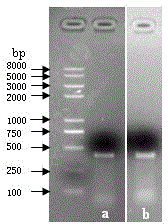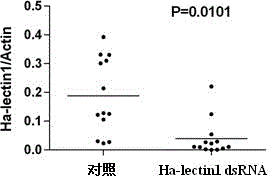Method for improving biological Helicoverpa armigera prevention and control effect of nuclear polyhedrosis viruses (NPVs)
A nuclear polyhedrosis, cotton bollworm technology, applied in the fields of botanical equipment and methods, insecticides, biocides, etc., can solve the problems of slow insecticidal effect, hinder the popularization and use, long effective period, etc., and achieve effective insecticidal effect. Faster action, reduced risk of resistance, reduced harm
- Summary
- Abstract
- Description
- Claims
- Application Information
AI Technical Summary
Problems solved by technology
Method used
Image
Examples
Embodiment 1
[0022] On the basis of work practice and research on prior art literature, the inventor found that C-type lectin (Ha-lectin1) in cotton bollworm can inhibit the proliferation of HaNPV in cotton bollworm , the inventors have carried out a series of experiments to prove this fact.
[0023] (1) RNA interference experiment
[0024] According to the cloned C-type lectin gene sequence of cotton bollworm (NCBI gene ID: ABF83203), we selected the 417bp region with low similarity with other sequences of cotton bollworm as the target sequence, and designed RNAi primers.
[0025] The above-mentioned 417bp cotton bollworm gene cDNA sequence has been published in the existing literature, and for the convenience of those skilled in the art to implement the present invention, it is republished as follows:
[0026] 5’-tacaagttccacagagtaccaggaacttttgatcgggctcactttgtttgttcggctgaaaacggccatcttgccattataaatagtgaagatgaagcggaagttttgagaaaagtctttgctgataatcctgctgcatggatacctggaaatttttggaaagacatagc...
Embodiment 2
[0046] Through a series of experiments in Example 1, it has been fully proved that C-type lectin (Ha-lectin1) can inhibit the proliferation of HaNPV in the cotton bollworm, so by inhibiting the transcription of the C-type lectin (Ha-lectin1) gene and expression, and silencing the C-type lectin (Ha-lectin1) gene of the cotton bollworm can enhance the insecticidal effect of HaNPV.
[0047] Studies have found that feeding dsRNA in insects can also cause silencing of target genes. Therefore, the inventors conducted further research on the feeding dosage of dsRNA of C-type lectin (Ha-lectin1) in cotton bollworm. The specific experimental research is as follows:
[0048] (1) Gene silencing caused by feeding different concentrations of dsRNA
[0049] Select 6 instar 12h cotton bollworm larvae, 20 in each group, and divide them into 4 groups. After 12 hours of starvation treatment, feed and spray 1ul concentrations of 0.5 ug / ul, 2.5 ug / ul, 3.0 ug / ul and 5.0 ug / ul respectively Ha-le...
PUM
 Login to View More
Login to View More Abstract
Description
Claims
Application Information
 Login to View More
Login to View More - R&D
- Intellectual Property
- Life Sciences
- Materials
- Tech Scout
- Unparalleled Data Quality
- Higher Quality Content
- 60% Fewer Hallucinations
Browse by: Latest US Patents, China's latest patents, Technical Efficacy Thesaurus, Application Domain, Technology Topic, Popular Technical Reports.
© 2025 PatSnap. All rights reserved.Legal|Privacy policy|Modern Slavery Act Transparency Statement|Sitemap|About US| Contact US: help@patsnap.com



